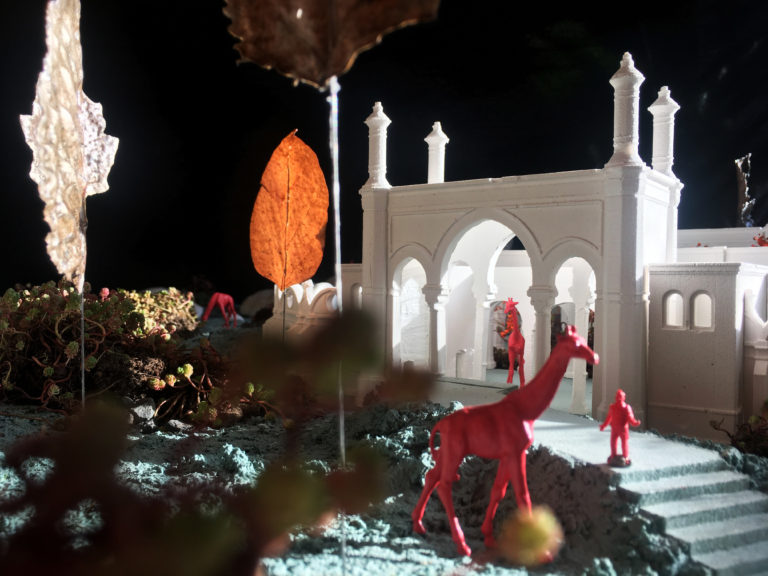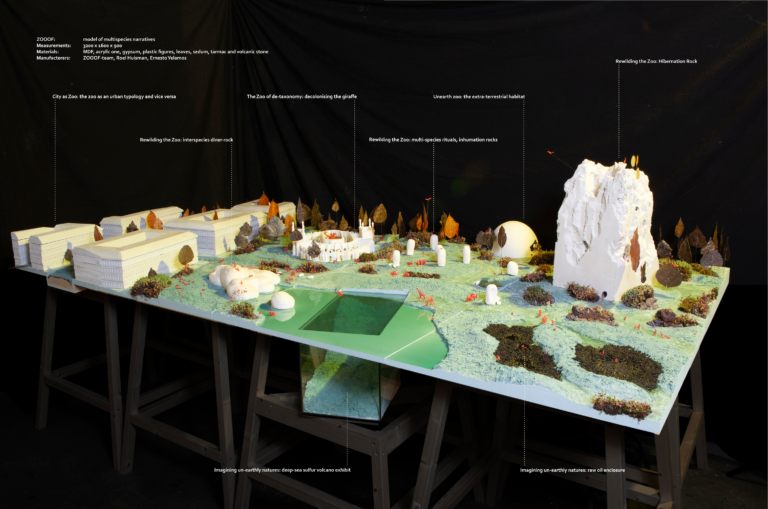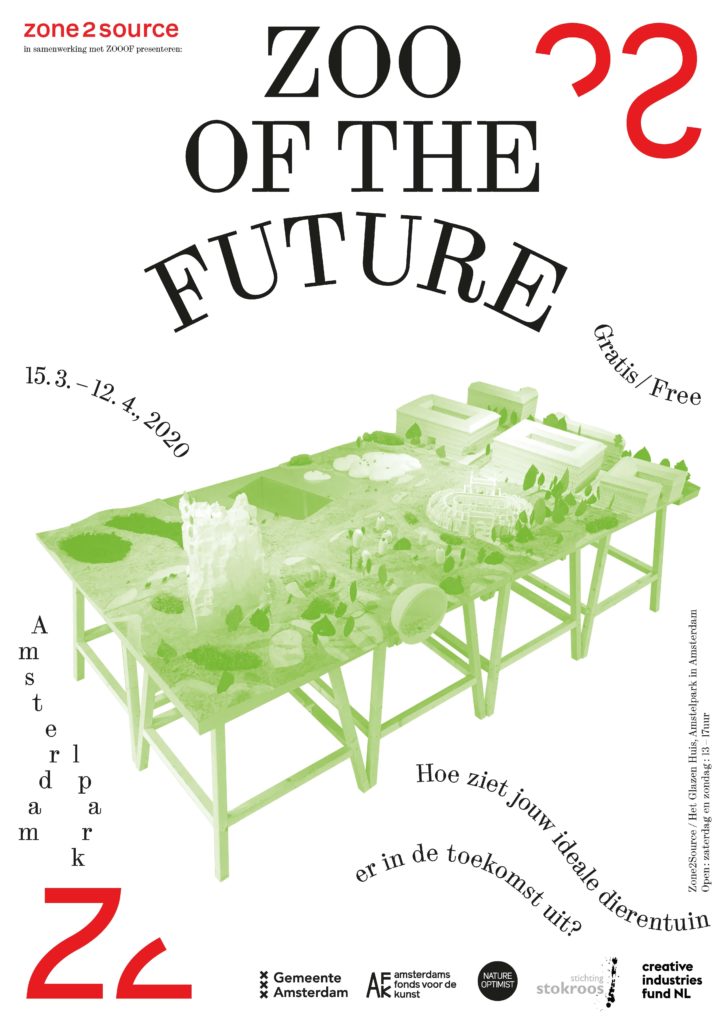ZOOOF
het Glazen Huis, March 15 – April 12, 2020 -> until June 1, 2020
Thijs de Zeeuw, David Habets, Bart de Hartog, Ira Koers, and Andrej Badin, Angelo Renna, Robin Winogrond
In collaboration with ZOOOF, Zone2Source presents the Zoo of the Future project from March 15 to June 1, 2020 . The Glass House is being converted into a fictional zoo enclosure, containing a large model. By looking at human-animal relationships from a number of different perspectives, artists and designers develop new proposals for the zoo of the future.
Tour the zoo of the future with Thijs de Zeeuw
View the photos or recordings below to get an impression of what the exhibition looks like.
Zoo of the Future (Quarantine pictures)
Letter to a zoo animal
The aim of the exhibition is to collect ideas about the zoo of the future. You can participate by writing a letter to an animal you want to encounter in the zoo of the future. Send your letter to brief@zooofthefuture.com . All submitted letters will be displayed in the window of the exhibition, you can read them on the ZOOF website and will be included in a publication
The exhibition would also feature Melanie Bonajo’s video work Progress vs Sunsets , but this has been canceled due to Corona. The program of expert meetings and workshops for children has been postponed.
Program (under the condition)Postponed
– open to the public every weekend from March 15 to Sunday April 12, admission free
– various meetings with students and experts on weekdays (private / on request)
– Zoo staff day (closed)
– children’s workshops on Wednesdays March 25 and April 1. With an expedition to the wild and captive animals in the Amstelpark and a workshop making a model of the zoo of the future. Costs 5 euros per child.
– final debate on Sunday April 5 from 2:00 PM to 5:00 PM with Dirk Sijmons, Barbara Visser, Haig Balian and Rivke Jaffe, among others.
Email info@zone2source.net to register children for workshops, or if you are interested in the substantive program during the week as a specialist, student or with a group.
More information about the program and ZOOOF under the footage of the model.
Footage from Zoo of the Future on Vimeo .
‘ Considering the implications of a new geological epoch, it is about time we review the way we look at animals. And what better place to look at animals than the zoo? By looking at human-nature relationships from a number of different perspectives we develop a number of (counter-) proposals for the non-human habitats in the contemporary zoo ‘.
ZOOOF (Zoo of the Future) is a long-term artistic research in which the changed relationship between humans and nature is explored with the zoo of the future as a testing ground. The aim of ZOOOF is to stimulate public debate and get people to think about the question: “How do we want to live together with the animals in the city in the future?” By looking at human-nature relationships from a number of different perspectives, ZOOF develops a number of (counter-)proposals for the non-human habitats in today’s zoo.
The ZOOF model is shown for the first time (a plaster model of 320 x 160cm) which forms the heart of the spatial installation, a fictional zoo enclosure (with plants, prunings and wood chips from the Amstelpark). A ‘future without a zoo’ and a ‘zoo without animals’ can coexist here alongside an ‘interplanetary zoo’ and ‘the city as a zoo’. The sometimes provocative proposals provoke reflection on the changing meaning of living with animals in the city.
In addition to the model, a selection of video and drawing work is shown, including Progress vs Sunsets by Melanie Bonajo and live-stream images from the model. Visitors are asked to write a letter to zoo animals. What future do you wish for an animal? The letters are collected and shown as a growing work during the exhibition.
Around this installation we organize a series of public and expert meetings for young and old and a final debate with various guests including Dirk Sijmons, Barbara Visser, Haig Balian, Rivke Jaffe and Eva Meijer.
Narratives as a means of imagination
The model is made up of four narratives that unravel the complexity of the contemporary zoo and provide space to think about change.
1. The Giraffe Garden
The zoo is the result of Western colonial urges and collecting frenzy. This is not only reflected in the animal collection but also in the classifying architecture of the zoo. The zoo of the future is looking for ways to change the imbalance of power between humans and animals.
2. The wild zoo
The wild zoo throws the visitor back on her intuition, the wildness within herself. She focuses on the similarities between humans and animals instead of the differences. In this zoo all your senses are needed, in this zoo you are an animal again.
3. The (un)Earthly zoo
‘We’re staying with the trouble… everywhere in the universe.’ The (un)Earthly zoo explores the unimaginable by making the extraterrestrial visible on Earth; what do extremophiles tell us about our own changing nature?
4. The city as a zoo
What does the city look like if we view it as a zoo? If infrastructure is also for animals; when the urban soil becomes accessible to life again and the streets become long parks?
The past period has shown that this narrative research method stimulates the imagination. This is how new narratives emerged such as the ‘voluntary zoo’ (Clemens Driessen), the ‘parliamentary zoo’ (UvA workshop) and the psychedelic zoo (workshop with EAZA and Aldo Hakman).
The narratives, model and works are the result of a three-year project supported by the Creative Industries Fund NL and the Stokroos Foundation (2017 – 2020). The exhibition is made possible by the Amsterdam Art Fund (AFK). Zone2Source is supported by the Creative Industries Fund NL and the Municipality of Amsterdam.
For more information see the ZOOOF website www.zooof.org .



Het Glazen Huis